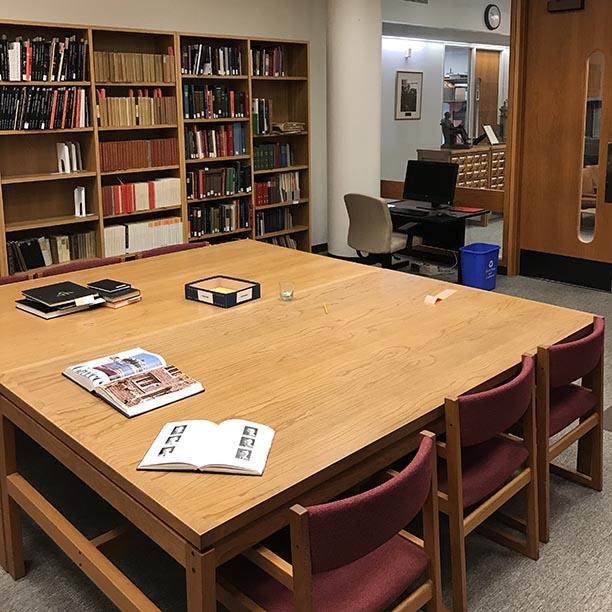“I believe in an open mind, but not so open that your brains fall out.”
— Arthur Hays Sulzberger
The library stands at the symbolic center of a Princeton education, cheek by jowl with the senior thesis. In his exhaustive examination of Princeton in the 20th century, Jim Axtell returns time and time again to various statistics showing the impact of the library — undergraduate and graduate students alike use it with frequency far beyond most colleges. The symbol of this completely intentional strategic effort toward open inquiry is Firestone Library — newly upgraded now following a monumental 10-year project — and its mile upon mile of open shelving beckoning the scholar and the information junkie alike. Is it the largest single open-stack facility in the world? Is it the largest open-stack system in combination with Lewis Science Library, Marquand, Engineering, Mendel, Architecture, East Asian, and other outposts? The ludicrous nature of the question is captured in the fact that, while it used to be heavily researched and debated among education specialists, it now appears nobody cares. The immediate ease of access to millions of volumes for a community of 10,000 students, faculty, and assorted hangers-on has an impact on what people have an opportunity to learn, what they actually do learn, and even on what they newly realize they could learn via simple serendipity.
This point is in reality a semi-clever ruse to drag you into my own current misery over the temporary shuttering of the Mudd Manuscript Library, closed until next January for a critical upgrade of, well, just about everything. Archives facilities are remarkably complex technical plants, and the original structure’s 40 years without a major rebuild is a tribute to its initial design and construction. Our great friends on the Mudd staff will be breaking their butts to get researchers what they need over at Firestone until the renovation is complete, with understandable changes to turnaround times and direct access. So I’m going to do everything I can to find research data elsewhere in the interim. This may be seen as a quality-of-life improvement by the Muddies, but I’ll go crazy.
But wait, you the Savvy Historian interject, wait! Mudd isn’t an open-shelf library, so where are we headed here? Well, to the Class of 1935 Room, to be precise, just off the main Mudd Lobby and across from the mud room (sorry…). It does indeed have shelves where you can touch things without corporal punishment, mainly complete sets of the Bric-a-Brac, Nassau Herald, and Freshman Herald; course catalogs; class reunion books; and Your Favorite Periodical, 120 years old and still perking along. But it also contains an odd and not-at-all comprehensive collection of volumes relating to the University’s history, its impact, and some of the personalities who’ve passed through Princeton. Sometimes while cramping up from trying to decipher hand-written trustees minutes from 1790 in the adjacent research room, I will go to those somewhat arbitrary open shelves and see what catches my eye.
So as a Hail and Farewell to Mudd, I decided to construct a column out of that, scientifically picking five volumes at random (via closing my eyes), and then describing them to you. I can pretty much assure you in advance I’d never look at any of them otherwise. Herewith, a wistful paean to the open-stack library.
Volume One of Five: John Witherspoon Comes to America, by L.H. Butterfield (Princeton University Library, 1953). Carl von Kienbusch 1906 and the Friends of the Library supported the gathering of newly available Witherspoon letters to Benjamin Rush 1760 and other contemporaries — his own files were burned in 1777 — to give a first-person picture of his decision to come to Princeton from Scotland, and his first impressions of the New World. Coincidentally, a topic we’ve discussed.
Volume Two of Five: Complicity: How the North Promoted, Prolonged and Profited from Slavery, by Anne Farrow, Joel Lang, and Jennifer Frank (The Hartford Courant, 2005). Engrossing detail of Yankees, most especially New Englanders, conniving to get richer during the United States’ first 80 years. This brings us to one of the common rites of open-shelf meandering: Why is this here? Princeton is not mentioned, New Jersey only in passing. None of the authors have Princeton connections I can divine. Perhaps an acquisition for the Princeton and Slavery Project? A lost thread somewhere.
Volume Three of Five: Pictorial History of Princeton, edited by Wheaton J. Lane ’25 *35 (Princeton University Press, 1947). Another coincidence, in this case a volume I already have in my personal library. At the University’s 1946 bicentennial, history professor Lane was nudged by the press office and the University Press into creating an oversized volume with examples of virtually every visual record of the place over those centuries, which (keep in mind Firestone didn’t yet exist) were gathered from dusty closets and shelves all over campus. Hundreds of black-and-white images with explanations, almost none of them dull. Loosely a companion piece to professor Thomas Wertenbaker’s great and fastidious work, Princeton 1746-1896, published simultaneously.
Volume Four of Five: Modernization from the Other Shore: American Intellectuals and the Romance of Russian Development, by David C. Engerman (Harvard University Press, 2003). A broad look at centuries of U.S. relations to the progression of semi- and non-successful attempts to reform Russia’s politics and economy. The reason they had to pry this from my cold, dead hands at 4:45 p.m. Mudd closing time is its very unusual examinations of both George Kennan ’25, from 1930 onward, and his cousin twice removed George Kennan “the Elder,” an explorer of Russia in the late 19th century who encouraged revolution but despised the Bolsheviks. There are 53 citations of the latter and 65 of the former in the volume; together, they covered 150 years of Russian history.
Volume Five of Five: Cold War, by Priscilla Roberts (Sutton Publishing, 2000). Part of a series popular for decades, the Sutton Pocket Histories, this undersized 100-page topical review is sharp enough to include James Forrestal 1915’s view in 1943 of the Soviet Union as a direct threat to the U.S., and not only Kennan ’25’s Long Telegram in 1946, but the eventual Soviet response to it. A great hour’s read by a savvy international affairs veteran.
But wait! There’s more! (That’s for those who keep claiming they’ve seen me on late night infomercials.) There on the high shelf right next to the little Roberts Cold War book, is a neat black binding with the stark message Chronology of Failure on it, nothing else. We can’t pass that up, right? So, I guess it’s…
Volume Six of Five: Chronology of Failure, by Hamilton Fish Armstrong 1916 (Macmillan, October 1940). Published in hardcover 14 weeks after the fall of France to the Nazis, it seethingly tracks, almost minute by minute, the non-decisions vacated by the French government for the prior 10 years, demonstrating how they were actually catastrophic decisions of substance in disguise. A blistering indictment by the esteemed editor of Foreign Affairs (he would eventually be there for 44 years), it not only reveals how not to behave when Hitler comes around, but by inference also how to prepare for Stalin, foreshadowing Kennan’s advice later in the decade. A vivid, frightening book.
And so we impute lessons from sampling this small but clever outpost of the vast Princeton open-stack library. First, don’t ask why stuff is there, just try it. Second, don’t judge a book by its cover or weight, just try it. And third, once you start, it’s really hard to stop. I went in with one simple goal — demonstrating open-shelf serendipity — and came out with that completed, but with two resulting, far more complex goals in its place. In the first case, I promise to write a column for you on Hamilton Fish Armstrong, one of the truly great Princetonians of the 20th century on the international front. And finally, as a matter of conscience, I should look into forming a search team for the couple of lost souls in your class — every class has them — who belatedly vanished into the shelves on C Floor in March of your senior year.











No responses yet